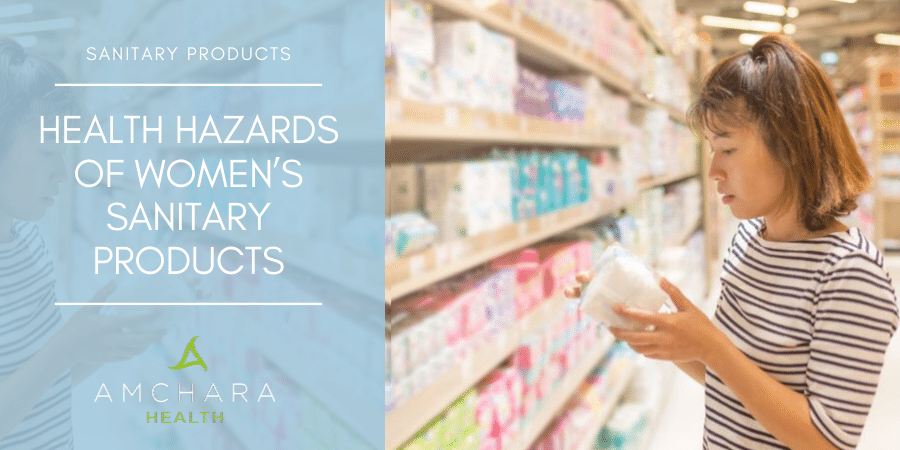Topics Covered in this article:
The global market for women’s sanitary products is estimated to be over £32 million.
On average a woman may use around 15-20 disposable sanitary products like tampons, pads or panty liners, for each period. With women experiencing up to 12 or 13 periods each year, the amount of disposable sanitary products being used starts to mount up.
The thought that these sanitary products may be hazardous to health may not cross many women’s minds as they become part of routine life but there are many hidden dangers.
In this article we take a look at some of the concerns.
Toxic chemicals
Conventional sanitary products like tampons are made with a combination of cotton and a synthetic fibre called rayon. Rayon is the only synthetic fibre permitted for use in tampons as other synthetic fibres have been linked to health concerns.
Traditionally tampons are white in colour, achieved by bleaching. The process of whitening the tampons leads to the release of toxic endocrine disrupting chemicals such as dioxins and trihalomethane (1).
Dioxin is a known carcinogen and has also been linked to changes in reproduction, immune functioning and development. These chemicals have also been shown to cause neurotoxic damage and have neurobehavioural effects (2).
Some of their effects include:
- Hormone and endocrine system disruption
- Weakening of the immune system
- Abnormal growth of abdominal and vaginal tissues
- Abnormal cell growth in the body
Sanitary pads are mostly made from crude oil plastic which contains BPA, BPS and phthalates like DEHP. Both BPA and DEHP are known endocrine disruptors (3), much like dioxins and are linked to a variety of issues such as:
- Increased incidence of infertility
- Genital tract abnormalities
- Breast cancer
- Obesity
- Endometrial hyperplasia
- Recurrent miscarriages
- Polycystic ovarian syndrome (PCOS) (4)
The skin inside and around the vagina is highly vascular meaning there is more potential for absorbing toxic chemicals. In fact, the vaginal mucus membranes are so effective for absorption that drugs given vaginally can be absorbed up to ten times more effectively than orally (5).
Long term exposure to the endocrine disrupting chemicals in sanitary products may be a cause for concern.
More recent products include the use of super absorbent gels, fragrances and odour neutralisers, all of which are often chemical based. Skin irritation and itching may occur in some sensitive individuals, which may be related to the addition of these chemicals.
Bacterial infection
One of the most publicised health concerns for using conventional tampons is that of Toxic Shock Syndrome (TSS). Caused by a bacterium called Staphylococcus aureus, TSS gives symptoms such as high fever, flu-like symptoms, nausea, vomiting, diarrhoea and a sunburn like rash.
It is classed as rare and has been linked to the use of super absorbent rayon containing tampons.
Since the removal in use of super absorbent fibres like polyacrylate rayon, polyester and carboxymethyl-cellulose (CMC) in tampons, the incidence of TSS has been reduced.
However, it does still occur and can be fatal if not treated early enough.
Environmental concerns
It is thought that each pack of sanitary pads uses the same amount of plastic as that found in 5 plastic bags.
Plastics used in the manufacture of sanitary pads, including polyethylene, are not readily biodegradable, so those that end up sitting in landfill sites further contaminate soil and water as the toxic chemicals leach out. As these plastics degrade, greenhouse gasses like methane and ethylene are released, adding to climate change.
A large proportion of sanitary products end up in oceans and on the seashore and are more commonly found than plastic bags (6).
Non-toxic alternatives
There are non-toxic menstrual hygiene products available including the following:
- Organic cotton tampons and plastic free sanitary pads – organically grown cotton is free from residues, chemical pesticides and fertilisers and pure cotton tampons do not contain rayon. They do not shed fibres within the vagina and show very little risk of inducing TSS (7). Plastic free organic cotton pads and panty liners have a reduced environmental impact and are free from endocrine disrupting chemicals and skin irritants.
- Menstrual cups – a silicone based flexible cup that is inserted into the vagina to collect menstrual flow. These are available in different sizes taking into account differing pelvic size and changes following childbirth. Users of menstrual cups report that they are comfortable and convenient as they can be left in situ for several hours. Unlike tampons they do not wick out natural vaginal secretions and so do not have a drying effect.
- Reusable fabric pads and period pants – cloth inserts for underwear or absorbent underwear are also available and whilst they may not be suitable for a heavy period flow they can be useful for a moderate to light flow. They have very little environmental impact, can be washed like other clothes and allow a natural menstrual flow.
The average woman has around 400 periods in her reproductive lifetime and using toxic sanitary products may contribute to the risk of hormone driven issues and potentially cancer.
Making changes to more natural, safe menstrual hygiene alternatives can have distinct advantages not only for your health but also for the environment.
If you would like to know more about hormones and health an experienced Personalised Health practitioner can discuss hormonal balance and your personal circumstances.
We’re dedicated to providing you with both insightful information and evidence-based content.
Did you find this article useful?
We’d love to hear your thoughts, get in touch!
Read this next:




